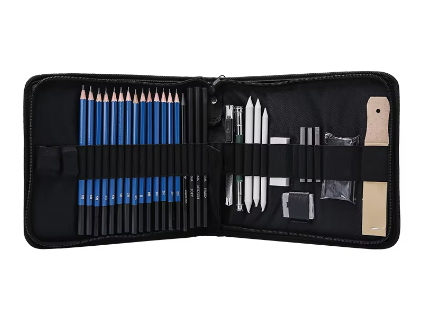Understanding Pencil Grades and Their Impact on Your Art
H vs. B: Decoding Graphite Hardness Scales
Pencil grades can significantly influence the outcome of your artwork by providing varying degrees of hardness and darkness. The graphite hardness scale ranges from H, representing harder pencils, to B, which indicates softer pencils. Harder pencils, such as those with an "H" grade, are composed of more clay and less graphite, making them ideal for producing fine lines and detailed work without much smudging. In contrast, softer "B" pencils have more graphite and less clay, which allows them to lay down darker, richer marks, perfect for shading and creating bold art pieces.
Notably, the HB pencil stands as an intermediate grade, balancing the characteristics of H and B pencils. It is designed to accommodate various artistic needs, providing versatility for general use. Its balanced graphite composition renders it ideal for beginners and professionals alike who require a pencil that can produce moderate lines and engage in sketching as smoothly as it participates in detailed illustrations. By understanding these distinctions, artists can select pencils that best enhance their drawing techniques and desired artistic effects.
Why Middle Grades Like HB and 2B Are Versatile Starters
Middle-grade pencils such as HB and 2B are highly favored by artists for their versatile applications. The HB pencil offers a balanced blend of hardness and softness, making it an excellent choice for a range of tasks—from drawing fine lines to executing broader sketches. This versatility makes the HB pencil a staple in artists' toolkits, allowing creatives to transition smoothly between writing and artistic expression without needing to switch pencils.
Similarly, the 2B pencil is celebrated for its ability to produce richer, darker lines while maintaining ease of control for the artist. It is particularly useful in drawing and sketching, delivering the darker values needed to add depth and dimension to portraits or landscapes. These qualities enable amateur and seasoned artists to explore various techniques with the assurance that their pencils can handle different demands. Embracing these middle-grade pencils in one's artistic practice can thus provide a versatile and reliable basis for experimenting with and mastering diverse artistic techniques.
Comparing Core Types: Graphite vs. Colored vs. Specialty Pencils
Graphite for Sketching: Precision and Shading Flexibility
Graphite pencils offer unrivaled precision for sketching, which is essential for creating detailed renderings. The different grades of graphite, ranging from hard (H) to soft (B), provide artists with flexibility in their shading techniques. For instance, harder pencils are perfect for fine lines and intricate details, while softer ones excel in creating gradients and textures. Popular graphite brands such as Staedtler and Faber-Castell offer pencils that are known for their consistent performance and durability.
Oil vs. Wax-Based Colored Pencils: Budget Considerations
Choosing between oil-based and wax-based colored pencils involves understanding differences in pigmentation and application. Wax-based pencils, like Prismacolor Premier, are generally more affordable and offer vibrant colors and smooth layering, making them popular among budget-conscious artists. However, they are prone to breaking. Oil-based pencils, such as Faber-Castell Polychromos, cost more but provide richer, more luminous colors and are less likely to break. When budgeting, it's essential to weigh the need for vividness against affordability and consider personal artistic requirements. Generally, wax-based pencils can range from $10 to $30, whereas oil-based options may start at $30 and go much higher.
Budget Factors Every Artist Should Evaluate
Price vs. Quality: Finding the Sweet Spot
When selecting Drawing Pencils, it's essential to weigh price against quality, as a higher price often equates to better performance and durability. I've discovered that several brands offer high-quality pencils at moderate prices, striking a balance between cost and functionality. For instance, Faber-Castell and Prismacolor provide exceptional Drawing Tools that aren't prohibitively expensive. Conducting tests before committing to a significant investment can be beneficial. I recommend buying sample packs or individual pencils to assess their performance and suitability for your needs.
Student-Grade vs. Professional Sets: When to Upgrade
Understanding the distinction between student-grade and professional sets is crucial for any artist. Student-grade sets typically feature basic materials suited for beginners, whereas professional sets offer superior quality and advanced functionalities. In choosing when to upgrade, it’s beneficial to consider examples from artists who have transitioned to professional sets and observed marked improvements in their work. As one progresses in skill, investing in professional-grade pencils becomes worthwhile, especially if expertise in detailed work or high-end projects is involved. Evaluating your skill level and project needs is key to determining the right time to invest in professional sets.
Long-Term Value: Investing in Durable Pencils
Investing in durable, high-quality drawing pencils potentially benefits artists financially over time. While cheaper alternatives may suffice for short-term use, premium pencils often boast longer lifespans, reducing frequent replacement costs. I find the testimonials from experienced artists particularly compelling; they reveal how opting for brands known for durability, like Caran d'Ache, translates into long-term cost savings. To maximize the lifespan of these tools, maintenance tips such as proper storage and minimal pressure during usage can help ensure longevity and prevent damage. By choosing quality over quantity, you foster efficiency and better artistic results.
How to Test Pencil Quality Without Breaking the Bank
Assessing Lead Consistency and Break Resistance
Assessing the lead consistency and break resistance of drawing pencils is crucial to determining their quality without overspending. One simple method involves applying varied pressure with the pencil while shading on a piece of scrap paper. A high-quality pencil will produce consistent, even lines without the lead breaking, even under increased pressure. Artists can perform these tests using materials readily available in any studio, like scrap paper and an eraser. Simply draw lines and apply pressure at intervals to observe any breakage or inconsistency. Renowned brands, such as Prismacolor and Staedtler, have been noted for their superior lead quality and performance in these tests, making them reliable options for artists seeking quality without a hefty investment.
Paper Compatibility: Smooth vs. Textured Surfaces
Testing pencil performance on different paper types is an essential step to understanding their compatibility and range. The texture of the paper can influence the appearance and application of pencil colors. Smooth paper surfaces tend to work best with soft pencils, providing a clean and even flow of color, whereas textured papers can enhance the depth and texture of hard lead pencils. Artists will find different results on various paper types, such as the smoother Bristol board or the textured watercolor paper, each providing unique outcomes for different pencil grades and colors. Affordable quality papers, like Strathmore's range, offer budget-friendly options that allow artists to conduct comprehensive tests without significant financial commitment. Through these tests, artists can establish which paper types complement their pencils best.
Tailoring Your Choice to Skill Level and Project Needs
Beginners: Starter Kits with Essential Grades
For beginners venturing into the world of drawing, starter kits equipped with essential pencil grades offer a valuable foundation. These kits often include a variety of grades from soft to hard pencils, typically ranging from 2B to HB. This variety allows novices to experiment with different tones and techniques. Art experts frequently highlight the benefit of having such variety early on, as it fosters a deeper understanding of shading and line work. One testimonial from an art education forum states, "Starter kits helped me discover my preferred pencil grade without a significant upfront investment." Brands like Faber-Castell and Derwent are highly recommended for their quality and diverse selection in starter kits, serving as excellent choices for beginners to explore.
Advanced Artists: Curating Custom Sets for Specific Techniques
Advanced artists often tailored their pencil choices to specific projects and techniques, creating custom sets that suit their sophisticated artistic needs. Whether it's shading, fine line work, or blending, selecting the right pencils can dramatically enhance creativity. For techniques requiring smooth transitions, softer pencils such as B or 2B are ideal, while harder pencils like H or 2H are better suited for detailed fine line work. Brands like Prismacolor and Caran d'Ache offer specialized pencils that cater to these needs, with options like oil-based or watercolor pencils. Opting for customized sets allows artists to refine their style and push the boundaries of their creative potential.
FAQ
What are the differences between H and B pencils?
H pencils are harder and contain more clay, making them suitable for fine lines with minimal smudging. B pencils are softer, contain more graphite, and are ideal for darker, richer marks.
Why are HB and 2B pencils recommended for artists?
HB and 2B pencils are versatile and can be used for different tasks, from writing to sketching. HB provides a balanced blend of hardness and softness, while 2B offers darker lines with easy control.
Should I choose oil-based or wax-based colored pencils?
Oil-based pencils provide rich, vivid colors and are more durable, while wax-based pencils are more affordable and offer vibrant colors but may break easily.
How can I test pencil quality before purchasing?
Perform simple tests by using varied pressure on scrap paper to assess lead consistency and strength without breaking. This method helps determine pencil durability and quality.
Can beginners start with professional-grade pencils?
Beginners should start with starter kits that offer a variety of grades, allowing them to explore different techniques before investing in professional-grade pencils.


